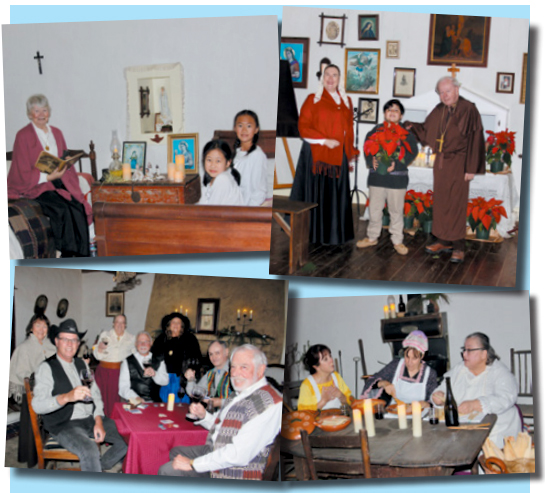Christmas 2021 at the Olivas. Photos by Patricia Schallert
by Richard Senate
What was Christmas like at the old Olivas Adobe long ago? It was very different from today. There was no Santa Claus, he is a northern European tradition that wouldn’t come to Mexico until the French occupation in the 1860s when they introduced “Papa Noel”. There were no Christmas Trees, that was a German Protestant tradition promoted by Martin Luther and made a worldwide sensation by Queen Victoria and Prince Albert. No, these present symbols of today’s Christmas Season were not a part of old California. But, do not be mistaken–it was still an important part of the year at the Missions, Ranchos and Pueblos. In fact the Christmas holiday was celebrated for nearly a month! The season started with the feast of our Lady of Guadalupe on December 12th and continued until The Feast of the Epiphany on January 6th. Nine days before Christmas Posadas were held reenacting the journey of Mary and Joseph in Bethlehem. Part procession, part musical they moved from house to house. with the Holy Couple being turned away until the end.
More popular was a play performed at the Missions and private residences called Las Pastorelas (the Shepard’s}. It was loosely based on a 15th Century Spanish mystery play. Many versions exist of the play and each one has the Shepard’s trying to visit the Christ Child. It features a clown named “Ermitano” and a vagabond named “Bartolo” as well as “El Diablo” and Saint Grabrail. The richest man in town was always selected to play the Devil. It is very possible Don Raymundo once played this part. The Devil was always booed and hissed at like a Victorian Melodrama villain. The play had songs, poems and action and no two were alike. Many were filled with jokes at the expense of the government and those in power. This was one place such comments were permitted. In the end kids dressed as Devils and Angels battled with wooden swords to determine if good or evil would win the day. The play had two endings depending on who won the conflict. After this a piñata was brought out for blindfolded children who struck the piñata (shaped in many cases like Satan). It was made of a decorated clay pot and filled with sweets, cactus candy and small toys. It was to teach them that fighting Satan would result in gifts from heaven.
The most important night of the celebration was “Nochabuena” (Good Night) with lavish parties, alcohol and dancing. At midnight all would go to the church for Midnight Mass– “La Misa del Gallo” (The Mass of the Rooster) The Rooster’s crowed at the birth of Christ, the first animal to announce his arrival. At the end of the Mass everyone greeted each other with the words “Feliz Nocha Buena” and “Felicia Pascuas.” Christmas Day was rather anti-climatic with most sleeping in and resting. It was called by some “The day of leftovers.” But what of gifts you ask? That would come on another day.
The feast of the Epiphany on January 6th was the time they were given and not by a jolly St. Nicolas. They were brought by the Three Kings, the wise men who brought gifts to the Christ Child. This was an old Italian tradition introduced by Spanish Missionaries long ago to tell the story of Christmas. Children would leave their shoes out with grass or straw for the horses of the Magi. In California these figures were always depicted mounted on beautiful Arabian Horses and not camels. (A king, so they figured, would never ride a smelly camel. After all, they spit!). The next morning the straw would be gone and gifts and toys left in their place.

